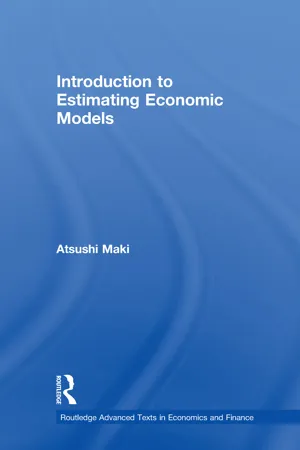![]()
1 Introduction
1.1 Overview
One of the objectives of empirical economic analysis is to understand the true relationship between variables through observations of data samples. This text is about the application of econometric methods to empirical analysis of a range of economic issues. By emphasizing the connection between economic theory and empirical analysis, this book fills the gap between textbooks on economic theory and econometrics. Students will engage examples of rigorous experimental design that link theoretical models with stochastic concepts and observations. They will also learn methods of estimation in econometrics. In addition, by using the data sets derived by the Monte Carlo method, they learn about the role of hypothesis testing in econometric models.
Usually we don't know the true relationships of variables a priori. However, in this textbook, we know the true relationships and true values of the parameters in a model a priori. Careful study leads to the conclusion: If a model is correctly specified, including the specification of the distribution of random variables, and the model is estimated by a suitable method, then we can obtain the estimates of the parameters of the true relationship from the sample observation.
By using the Monte Carlo method, I conduct an ideal experiment in the econometric laboratory, one that aims to show the importance of economic theory and experimental design connecting model and observation.
This textbook covers consumer behavior, producer behavior, market equilibrium models, macroeconomic models, qualitative-response models using micro-data, fixed-effects and random-effects models utilizing panel data, and macroeconomic time series analyses. Through careful study, students of economics and econometrics will come to understand how to estimate econometric models and confirm the accuracy of the estimates compared with the true values in the model by applying hypothesis testing, and will also learn how to evaluate related policy implications.
1.2 Experimental design
Experimental design in economics is similar to designing experimental instruments in the natural sciences. In the empirical analysis of economics, models are estimated using data sets in order to make a structure, test the applicability of the structure through theoretical analysis and statistical testing, and conduct forecasting to test the robustness of the structure.
The three fundamental aspects of experimental design are:
1 determining the unit;
2 determining the observational period;
3 establishing the correspondence between theoretical and observational variables.
Determining the unit involves deciding the theoretical unit of a model, such as the individual household, individual firm, or government, or the representative household or representative firm. Aggregated data rely on the representative concept, while micro-data sets rely on the individual unit.
The observational period could be a day, week, or month, or it could be quarterly, semi-annual, or annual. For example, security markets’ sales data covering market prices and quantities is available every minute, while the System of National Accounts (SNA) is published on a quarterly and annual basis, and corporate financial data are published semi-annually. The observational unit is strongly dependent on the data sets used.
As for the correspondence between theoretical and observational variables, in theory we usually write p for price, but in empirical analysis, price is strictly defined by the data, such as the price of food as published in the Family Expenditure Survey.
The principal purpose of experimental design is to ensure the reproducibility of empirical results. Anyone using the same data and methods should be able to produce the same results. The second purpose of experimental design concerns the development of economic science. Whether an experiment is successful or not, the results are made available to the general public and other researchers. In published papers, the goal is to add to previous research and suggest avenues for further study.
To elucidate experimental design, let's consider an estimation of the consumer-demand function, one involving a time series for household behavior for food consumption. It is important to construct a model according to economic theory. The foundation of consumer behavior is to assume the existence of a utility function and to consume goods and services so as to maximize utility under the budget constraint. Here, consumers behave as price-takers. In this framework, exogenous variables are income and prices, and endogenous variables are quantities consumed. The constants to be estimated are parameters of the utility function. The utility function is specified as the linear expenditure system (LES) type utility function; for simplicity, as an example, total expenditure is divided into two categories, namely food and other items. The utility function is:
u = β1 log(x1−α1) + β2 log(x2−α2) (1)
and the budget constraint is:
y = p1x1+ p2x2 (2)
where α1, α2, β1, and β2 are the parameters of the utility function, p1 and p2 are prices of food and other items, respectively, and y is income. To maximize the utility function under the budget constraint, we use the Lagrange multiplier method:
V = β1 log(x1 − α1) + β2 log(x2 − α2) + λ(y − p1x1 − p2x2) (3)
The necessary conditions for maximization are:
∂V/∂x1= β1/(x1 − α1) − λp1 = 0
∂V/∂x2= β2/(x2 − α2) − λp2 = 0
∂V/∂λ = y − p1x1 − p2x2= 0 (4)
Solving the system with expenditures of p1x1 and p2x2, we get:
p1x1= β1/(β1 + β2)y + β2/(β1 + β2)α1p1 − β1/(β1+ β2)α2p2
p2x2= β2/(β1 + β2)y − β2/(β1 + β2)α1p1...
